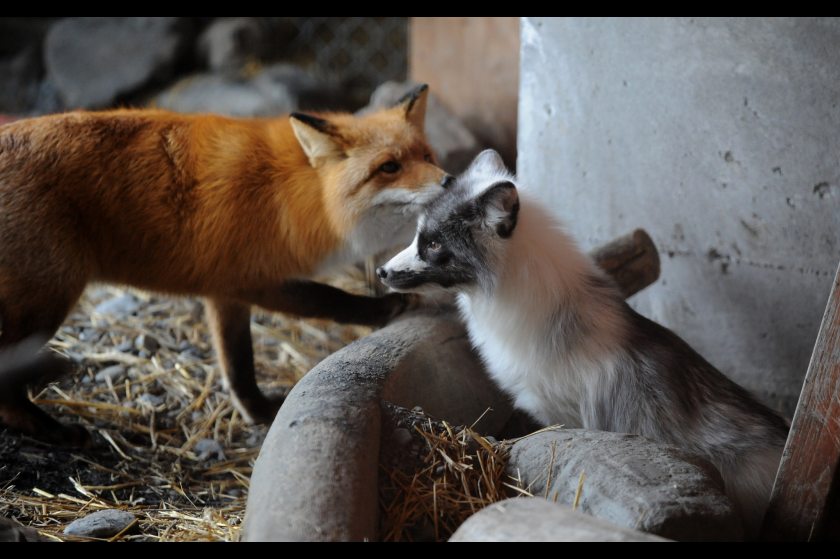Newly arrived fox makes fast friends at Alaska Wildlife Conservation Centre (with video)

PORTAGE — Employees at the Alaska Wildlife Conservation Centre were breathing a sigh of relief Tuesday morning as the center’s newest rescue animal, a female marble fox named Storm, quickly took to her new surroundings.
Storm was released into her new enclosure with Jade, the centre’s 3-year-old male red fox, around 9:30 a.m. Tuesday, said animal supervisor Sarah Howard. Storm joins numerous other rescue animals at the conservation centre, which sits on more than 200 acres of land roughly an hour’s drive south of Anchorage.
“She came right out and was walking around with all of us in here, so that’s an amazing sign,” said fox trainer Teal Goodsell, who spent the morning watching over the foxes.
Storm was rescued from a home in Montana where she was kept as a pet (it’s illegal to have pet foxes in many states, including Alaska.) Her unique black-and-white coloring makes Storm a “marble phase” red fox, Howard said. Marble foxes are bred in captivity specifically for their coloring as part of the fur trade.
A few hours after Storm’s release, the two foxes seemed to be acclimating to each other. Storm walked around the enclosure, sniffing and occasionally digging at the ground. Jade watched her, sometimes following and sniffing at her. When she lay down and curled up in a ball, he approached and they sniffed each other.
With the introduction of Storm, Jade is, for the first time in his adult life, interacting with another fox.
Jade was only a few months old when he was brought to the center about three years ago, Goodsell said. Someone had found him outside of a trailer home in Anchorage. The center believes he may have also been someone’s pet.
“He was very accustomed to people already,” Goodsell said.
Goodsell began working at the center a few weeks before Jade arrived, so she’s known him for most of his life. She was happy that he’d have a “constant companion” now.
“It’s really cool for me to see,” Goodsell said.
‘Operant conditioning’
Storm was released Tuesday, but arrived at the facility about a month ago. She was spayed (Jade is also neutered) and then quarantined in a kennel next to the enclosure, so the two foxes could smell and see each other. Storm seemed friendly to Jade even then, and would make play stances at Jade through the fencing, Goodsell said.
Now, Storm will join Jade in being trained by a process called “operant conditioning” which emphasizes reward and does not involve discipline of an animal, Howard said.
“They’re pretty much in charge of the session. If they want to train they train, if they don’t they don’t,” Goodsell said. Through the use of food as reinforcement, the animals can be socialized and taught different skills.
For instance, Jade now voluntarily gets his injections — after some training that involved being poked lightly by a stick, he willingly sat for a rabies shot a few weeks ago, Goodsell said. That training reduces the stress for Jade, who now doesn’t need to be dragged to a veterinarian for shots, she added.
Training makes life easier on the animals, and offers mental stimulation. “They do like to learn … they’re such intelligent animals,” Goodsell said.
The center hopes to expand the foxes’ enclosure this summer to somewhere between one-quarter and one-half acre, Goodsell said.
For now the employees are happy that Storm and Jade have hit it off. “After seeing this morning it was just like … ahhh,” Howard sighed with relief.
Related stories from around the North:
Canada: Caribou or development? Question debated in Arctic communities, Eye on the Arctic
Norway: Eagle attacks military drone, Barents Observer
Russia: Is mercury harming foxes in the Russian Arctic?, Eye on the Arctic
Sweden: Arctic foxes making a comeback in Sweden, Radio Sweden
United States: Did Arctic fox evolve from Himalayas?, Alaska Dispatch News



